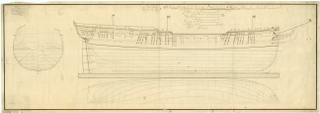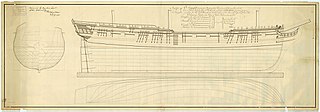Related Research Articles

HMS Indefatigable was one of the Ardent-class 64-gun third-rate ships-of-the-line designed by Sir Thomas Slade in 1761 for the Royal Navy. She was built as a ship-of-the-line, but most of her active service took place after her conversion to a 44-gun razee frigate. She had a long career under several distinguished commanders, serving throughout the French Revolutionary Wars and the Napoleonic Wars. She took some 27 prizes, alone or in company, and the Admiralty authorised the issue of four clasps to the Naval General Service Medal in 1847 to any surviving members of her crews from the respective actions. She was broken up in 1816.

HMS Sirius was a 36-gun fifth-rate frigate of the Royal Navy. Between 1797 and 1805, the Sirius was engaged in maintaining the blockade of Napoleonic Europe. She was lost in 1810 when her crew scuttled her after she grounded during the Battle of Grand Port.

HMS Cerberus was a 32-gun fifth-rate frigate of the Royal Navy. She served in the French Revolutionary and the Napoleonic Wars in the Channel, the Mediterranean, the Adriatic, and even briefly in the Baltic against the Russians. She participated in one boat action that won for her crew a clasp to the Naval General Service Medal (NGSM). She also captured many privateers and merchant vessels. Her biggest battle was the Battle of Lissa, which won for her crew another clasp to the NGSM. She was sold in 1814.

HMS Unicorn was a 32-gun fifth-rate Pallas-class frigate of the Royal Navy, launched in 1794 at Chatham. This frigate served in both the French Revolutionary Wars and the Napoleonic Wars, including a medal action early in her career. She was broken up in 1815.

HMS Spitfire was a Tisiphone-class fireship of the Royal Navy. She served during the years of peace following the end of the American War of Independence, and by the outbreak of the French Revolutionary Wars, had been reclassified as a 14-gun sloop-of-war. Spitfire went on to serve under a number of notable commanders during a successful career that saw her capture a considerable number of French privateers and small naval vessels. She spent most of her career in Home waters, though during the later part of her life she sailed further afield, to the British stations in North America and West Africa. She survived the Napoleonic Wars and was eventually sold in 1825 after a period spent laid up.
During the French Revolutionary and Napoleonic Wars the British Royal Navy made use of hired armed vessels, one of which was His Majesty's hired armed cutter Nimrod. Three such vessels are recorded, but the descriptions of these vessels and the dates of their service are such that they may well represent one vessel under successive contracts. The vessel or vessels cruised, blockaded, carried despatches, and performed reconnaissance.
During the period of the French Revolutionary and Napoleonic Wars, there were two or three vessels known as His Majesty's hired armed cutter Active that served the British Royal Navy. The reason for the uncertainty in the number is that the size of the vessels raises the possibility that the first and second may have been the same vessel.

HMS Cruizer was a Royal Navy Cruizer-class brig-sloop built by Stephen Teague of Ipswich and launched in 1797. She was the first ship of the class, but there was a gap of 5 years between her launch and the ordering of the next batch in October 1803; by 1815 a total of 105 other vessels had been ordered to her design. She had an eventful wartime career, mostly in the North Sea, English Channel and the Baltic, and captured some 15 privateers and warships, and many merchant vessels. She also participated in several actions. She was laid up in 1813 and the Commissioners of the Navy sold her for breaking in 1819.
There were two, and possibly three, vessels named His Majesty's hired armed brig Ann that served the British Royal Navy. The first participated in an engagement in 1807 that would earn her crew the Naval General Service Medal. She is sometimes referred to in sources as the hired armed cutter Ann or the hired armed brig Anne. Little or nothing is known of the second and third hired armed brigs Ann or Anne.
During the French Revolutionary and Napoleonic Wars, British vessels captured at least 12 French warships and privateers named Espoir, which means “Hope” in French. In only one case was there mention of an exchange of fire or casualties. In general, the privateers tried to escape, and failing that surrendered.

His Majesty's hired armed cutter Telemachus served the Royal Navy from 17 June 1795 until 15 January 1801. She was of 1285⁄95 tons (bm), and carried fourteen 4-pounder guns. During her five and a half years of service to the Royal Navy, she captured eight French privateers as well as many merchant vessels.

HMS Racoon was a brig-sloop built and launched in 1795. She served during the French Revolutionary Wars and in the beginning of the Napoleonic Wars. She had an active career under several captains, working essentially independently while capturing or destroying some 20 enemy privateers and naval vessels. Several of the captures involved engagements that resulted in casualties on Racoon as well as on her opponents. She was broken up early in 1806.
Two vessels have borne the designation, His Majesty's hired armed cutter Lion. The first served during the French Revolutionary Wars, capturing five privateers and several merchant vessels. The second served briefly at the start of the Napoleonic Wars. Both vessels operated in the Channel. The two cutters may have been the same vessel; at this juncture it is impossible to know. French records report that the French captured the second Lion in 1808 and that she served in the French Navy until 1809.
HMS Dolphin was 10-gun cutter that served the Royal Navy from 1793 to 1802, first as a hired armed cutter, and then after the Navy purchased her, as HMS Dolphin. During her almost decade of service Dolphin patrolled the English Channel protecting British trade by capturing French privateers and recapturing their prizes.

HMS Childers was a brig-sloop of the British Royal Navy, initially armed with 10 carriage guns which were later increased to 14 guns. The first brig-sloop to be built for the Navy, she was ordered from a commercial builder during the early years of the American War of Independence, and went on to support operations in the English Channel and the Caribbean. Laid up for a time after the end of the American War of Independence, she returned to service shortly before the outbreak of the French Revolutionary Wars. She had an active career in both the French Revolutionary and Napoleonic Wars, capturing numerous French privateers and during the Gunboat War participated in a noteworthy single-ship action. The navy withdrew her from service at the beginning of 1811, at which time she was broken up.

HMS Seagull, was a Royal Navy Diligence-class brig-sloop, launched in 1795. During the French Revolutionary Wars she shared in the capture of a number of small French and Dutch privateers. Then early in the Napoleonic Wars she participated in a notable single-ship action before she disappeared without a trace in 1805.
His Majesty's Hired armed lugger Speedwell served the Royal Navy on contract between 11 June 1796 and 31 October 1801. She had a burthen of 15215⁄94 tons (bm), and was armed with fourteen 4-pounder guns.
Jalouse was an 18-gun Belliqueuse-class brig-corvette of the French Navy, built to a design by Pierre-Alexandre-Laurent Forfait, and launched in 1794 at Honfleur. The Royal Navy captured her in May 1797 and took her into service under her existing name. In British service she served primarily on the North Sea station where she captured three small French privateers, and many Dutch merchant vessels. She also participated with other British warships in two or three major cutting-out expeditions. She was broken up in 1807.
His Majesty's hired armed vessel Marechal de Cobourg served the British Royal Navy under contract during the French Revolutionary Wars. Contemporary records also referred to her as Marshall de Cobourg, Marshall Cobourg, Marshall Cobourg, Marquis Cobourg, Marquis de Cobourg, Cobourg, Coborg, and Saxe Cobourg. Further adding to the difficulty in tracking her through the records, is that although she was originally a cutter, later the Navy converted her to a brig.
HM hired armed cutter Flora served the British Royal Navy under contract from 16 August 1794 until a French privateer captured her on 1 December 1798.
References
- Grocott, Terence (1997), Shipwrecks of the revolutionary and Napoleonic eras, Chatham, ISBN 1-86176-030-2
- Hepper, David J. (1994). British Warship Losses in the Age of Sail, 1650-1859. Rotherfield: Jean Boudriot. ISBN 0-948864-30-3.
- James, William (1837). The Naval History of Great Britain, from the Declaration of War by France in 1793, to the Accession of George IV. Vol. 5. R. Bentley.
- Winfield, Rif (2008). British Warships in the Age of Sail 1793–1817: Design, Construction, Careers and Fates. Seaforth. ISBN 1-86176-246-1.
This article includes data released under a Creative Commons Attribution-ShareAlike 3.0 Unported UK: England & Wales Licence, by the National Maritime Museum, as part of the Warship Histories project.